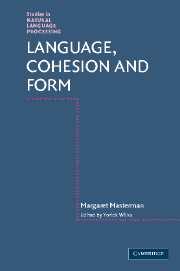Book contents
- Frontmatter
- Contents
- Preface
- Editor's introduction
- Part 1 Basic forms for language structure
- Part 2 The thesaurus as a tool for machine translation
- Part 3 Experiments in machine translation
- Part 4 Phrasings, breath groups and text processing
- 9 Commentary on the Guberina hypothesis
- 10 Semantic algorithms
- Part 5 Metaphor, analogy and the philosophy of science
- Bibliography of the scientific works of Margaret Masterman
- Other References
- Index
10 - Semantic algorithms
Published online by Cambridge University Press: 22 September 2009
- Frontmatter
- Contents
- Preface
- Editor's introduction
- Part 1 Basic forms for language structure
- Part 2 The thesaurus as a tool for machine translation
- Part 3 Experiments in machine translation
- Part 4 Phrasings, breath groups and text processing
- 9 Commentary on the Guberina hypothesis
- 10 Semantic algorithms
- Part 5 Metaphor, analogy and the philosophy of science
- Bibliography of the scientific works of Margaret Masterman
- Other References
- Index
Summary
The purpose of the paper that I want here to present is to make a suggestion for computing semantic paragraph patterns.
I had thought that just putting forward this suggestion would involve putting forward a way of looking at language so different from that of everyone else present, either from the logical side or the linguistic side, that I would get bogged down in peripheral controversy to the extent of never getting to the point. I was going to start by saying, ‘Put on my tomb: “This is what she was trying for”.’ But it is not so.
I don't know what has happened, but I don't disagree with Yehoshua Bar-Hillel as much as I did.
And on the linguistic side I owe this whole colloquium an apology and put forward the excuse that I was ill. I ought to have mastered the work of Weinreich (1971). I am trying to. But it is not just that simple a matter to master a complex work in a discipline quite different from that which one ordinarily follows.
I may misinterpret, but it seems to me that the kind of suggestion I put forward in this paper could be construed as a crude way of doing the kind of thing Weinreich has asked for. But Yehoshua Bar-Hillel is actually very right when he wants to question all the time what real use the computer can be in this field. So don't be misled by the size of the output in this paper.
Information
- Type
- Chapter
- Information
- Language, Cohesion and Form , pp. 253 - 280Publisher: Cambridge University PressPrint publication year: 2005
